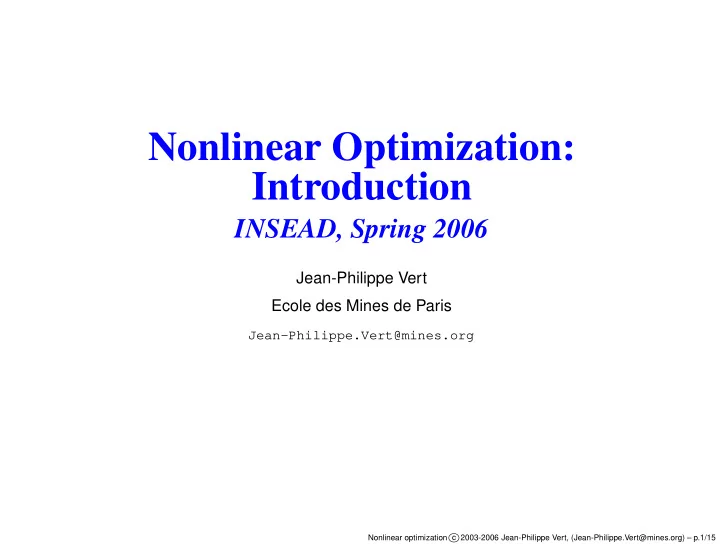

Nonlinear Optimization: Introduction INSEAD, Spring 2006 Jean-Philippe Vert Ecole des Mines de Paris Jean-Philippe.Vert@mines.org � 2003-2006 Jean-Philippe Vert, (Jean-Philippe.Vert@mines.org) – p.1/15 Nonlinear optimization c
Optimization problem minimize f ( x ) subject to x ∈ X x : a decision variable X : the constraint set , i.e., available decisions f : X → R : the cost or objective function We want to find an optimal decision , i.e., an x ∗ ∈ X such that: f ( x ∗ ) ≤ f ( x ) , ∀ x ∈ X . � 2003-2006 Jean-Philippe Vert, (Jean-Philippe.Vert@mines.org) – p.2/15 Nonlinear optimization c
Where do optimization problems arise? Economics : Consumer theory / supplier theory Finance : Optimal hedging / pricing Statistics : data fitting, regression, pattern recognition Science / Engineering : Aerospace, product design, data mining Other Business decisions : scheduling, production, organizational decisions Government : Military applications, fund allocation, etc Other Personal decisions : Sports, on-field decisions, player acquisition, marketing � 2003-2006 Jean-Philippe Vert, (Jean-Philippe.Vert@mines.org) – p.3/15 Nonlinear optimization c
Example Portfolio optimization variables: amount invested in different assets constraint: budget, max/min investment per asset, minimum return objective: overall risk, or return variance Device sizing in electronic circuits variables: device width and lengths constraints: manufacturing limits, max area power consumption Data fitting variable: model parameters contraints: prior information, parameter limits objective: measure of misfit, prediction error � 2003-2006 Jean-Philippe Vert, (Jean-Philippe.Vert@mines.org) – p.4/15 Nonlinear optimization c
Classification of optimization problems X is discrete/finite , e.g. integer programming (scheduling, route planning) X ⊂ R d is continuous Linear programming (LP) : f is linear and X is a polyhedron specified by linear equalities and inequalities. Quadratic programming (QP) : f is convex quadratic and X is a polyhedron specified by linear equalities and inequalities. Convex programming : f is a convex function and X is a convex set. Nonlinear programming : f is nonlinear, and/or X is specified by nonlinear equalities and inequalities. � 2003-2006 Jean-Philippe Vert, (Jean-Philippe.Vert@mines.org) – p.5/15 Nonlinear optimization c
Solving optimization problems General optimization problem very difficult to solve methods involve some compromise , e.g., very long computation time, or not always finding the solution Exceptions : certain problem classes can be solved efficiently and reliably least-square problems linear programming problems convex optimization problems � 2003-2006 Jean-Philippe Vert, (Jean-Philippe.Vert@mines.org) – p.6/15 Nonlinear optimization c
Least squares � Ax − b � 2 minimize 2 � − 1 A ⊤ b analytical solution x ∗ = � A ⊤ A reliable and efficient algorithms and softwares a mature technology least-square problems are easy to recognize � 2003-2006 Jean-Philippe Vert, (Jean-Philippe.Vert@mines.org) – p.7/15 Nonlinear optimization c
Linear programming c ⊤ x minimize a ⊤ subject to i x ≤ b i , i = 1 , . . . , m no analytical formula for solution reliable and efficient algorithms and software (simplex algorithm, interior-point methods) a mature technology not as easy to recognize as least-square problems a few standard tricks to convert problems into linear programs � 2003-2006 Jean-Philippe Vert, (Jean-Philippe.Vert@mines.org) – p.8/15 Nonlinear optimization c
Convex optimization minimize f ( x ) subject to g i ( x ) ≤ b i , i = 1 , . . . , m f and g i are convex: f ( αx + βy ) ≤ αf ( x ) + βf ( y ) if α, β ≥ 0 , α + β = 1 . include least-squares and linear programming no analytical solution reliable and efficient algorithms almost a technology often difficult to recognize � 2003-2006 Jean-Philippe Vert, (Jean-Philippe.Vert@mines.org) – p.9/15 Nonlinear optimization c
Brief history 1947: simplex algorithm for linear programming (Dantzig) 1960s: early interior-point methods (Fiacco & McCormick, Dikin, ...) 1970s: ellipsoid method and other subgradient methods 1980s: polynomial-time interior-point methods for linear programming (Karmarkar 1984) late 1980s-now: polynomial-time interior-point methods for nonlinear convex optimization (Nesterov & Nemirovski 1994) � 2003-2006 Jean-Philippe Vert, (Jean-Philippe.Vert@mines.org) – p.10/15 Nonlinear optimization c
The optimization process (1/2) Formulate real life problems into mathematical models Study the environment and clearly understand the problem Formulate the problem using verbal description Define notations for parameters and decision variables Construct a model using mathematical expressions Collect necessary data; Transform the raw data to parameter values Implement the model and solution algorithms using a computer : analyze the models and develop efficient procedures to obtain best solutions � 2003-2006 Jean-Philippe Vert, (Jean-Philippe.Vert@mines.org) – p.11/15 Nonlinear optimization c
The optimization process (2/2) Interpret computer solutions and perform sensitivity analysis Implementation : put the knowledge gained from the solution to work Monitor the validity and effectiveness of the model and update it when necessary � 2003-2006 Jean-Philippe Vert, (Jean-Philippe.Vert@mines.org) – p.12/15 Nonlinear optimization c
What you will learn Models - the art: How we choose to represent real problems Theory - the science: What we know about different classes of models; e.g. necessary and sufficient conditions for optimality Algorithms - the tools: How we apply the theory to robustly and efficiently solve powerful models � 2003-2006 Jean-Philippe Vert, (Jean-Philippe.Vert@mines.org) – p.13/15 Nonlinear optimization c
Course outline Modeling and reformulating Optimality conditions Duality theory and sensitivity analysis Algorithms for unconstrained problems Algorithms for linearly constrained problems Algorithms for convex problems Applications � 2003-2006 Jean-Philippe Vert, (Jean-Philippe.Vert@mines.org) – p.14/15 Nonlinear optimization c
Practical informations Course web page: http://cbio.ensmp.fr/˜vert/teaching/2006insead schedule slides references, links.. 10 × 2 h Grading: weekly homework (50%), article presentation (10%), final exam (40%) � 2003-2006 Jean-Philippe Vert, (Jean-Philippe.Vert@mines.org) – p.15/15 Nonlinear optimization c
Recommend
More recommend